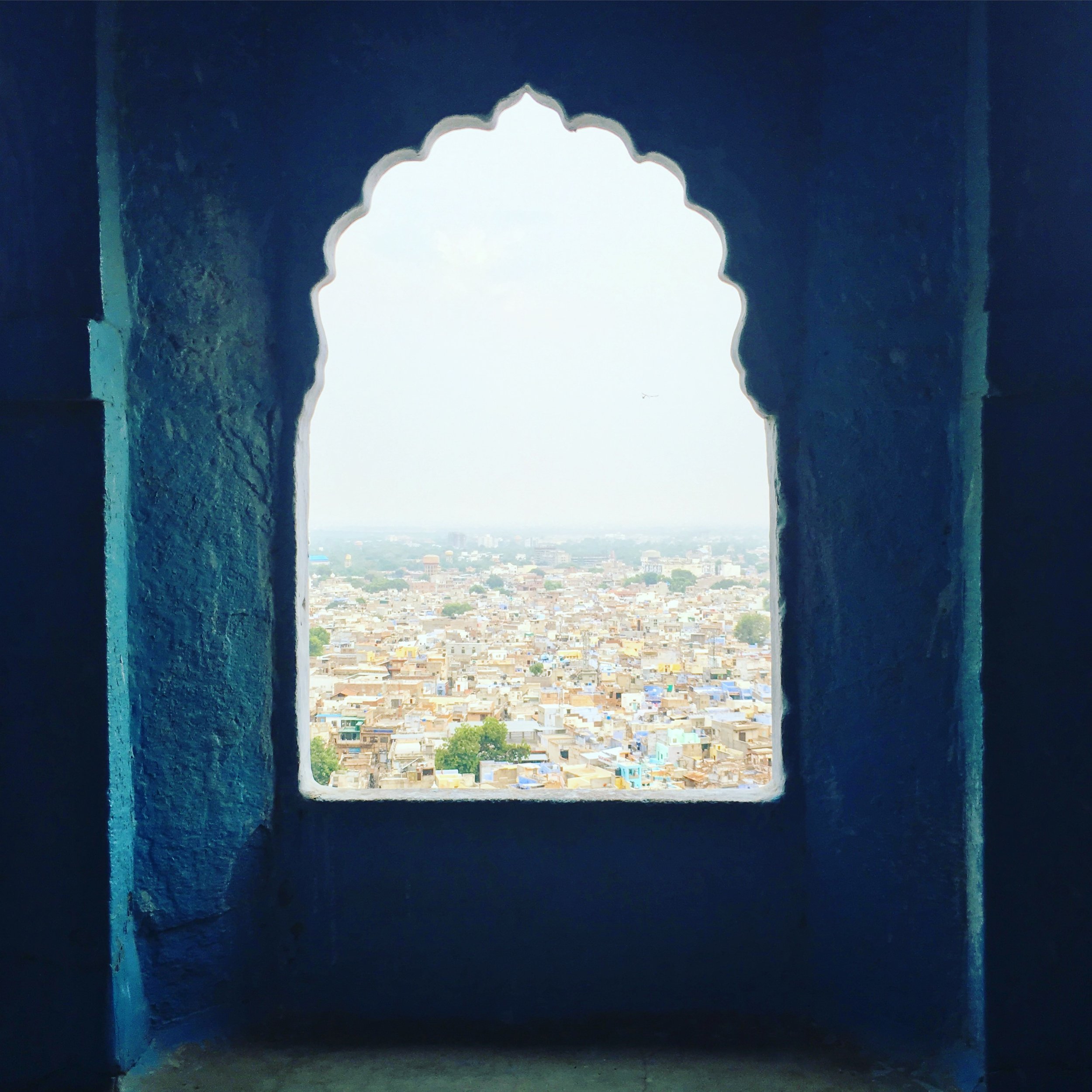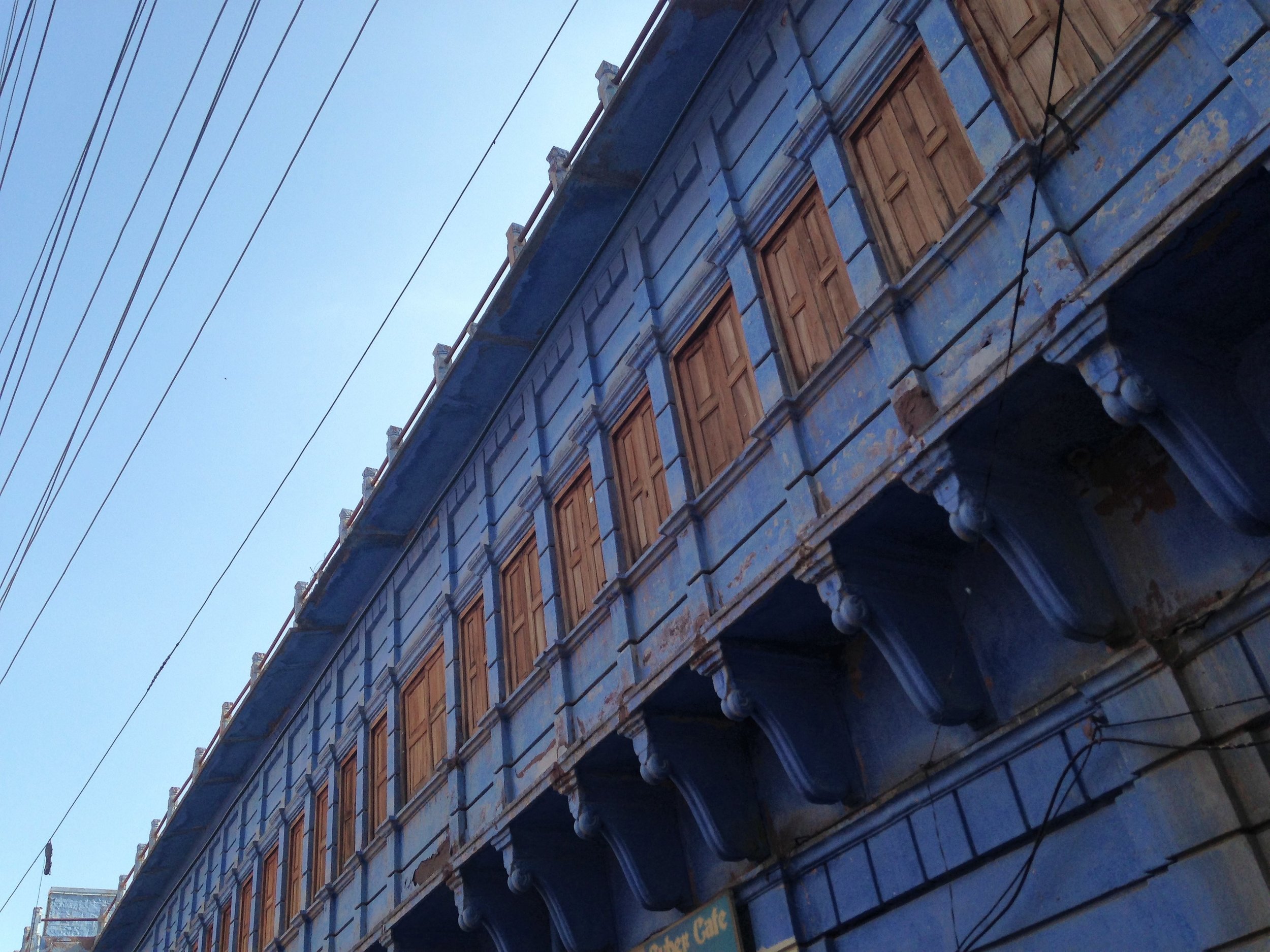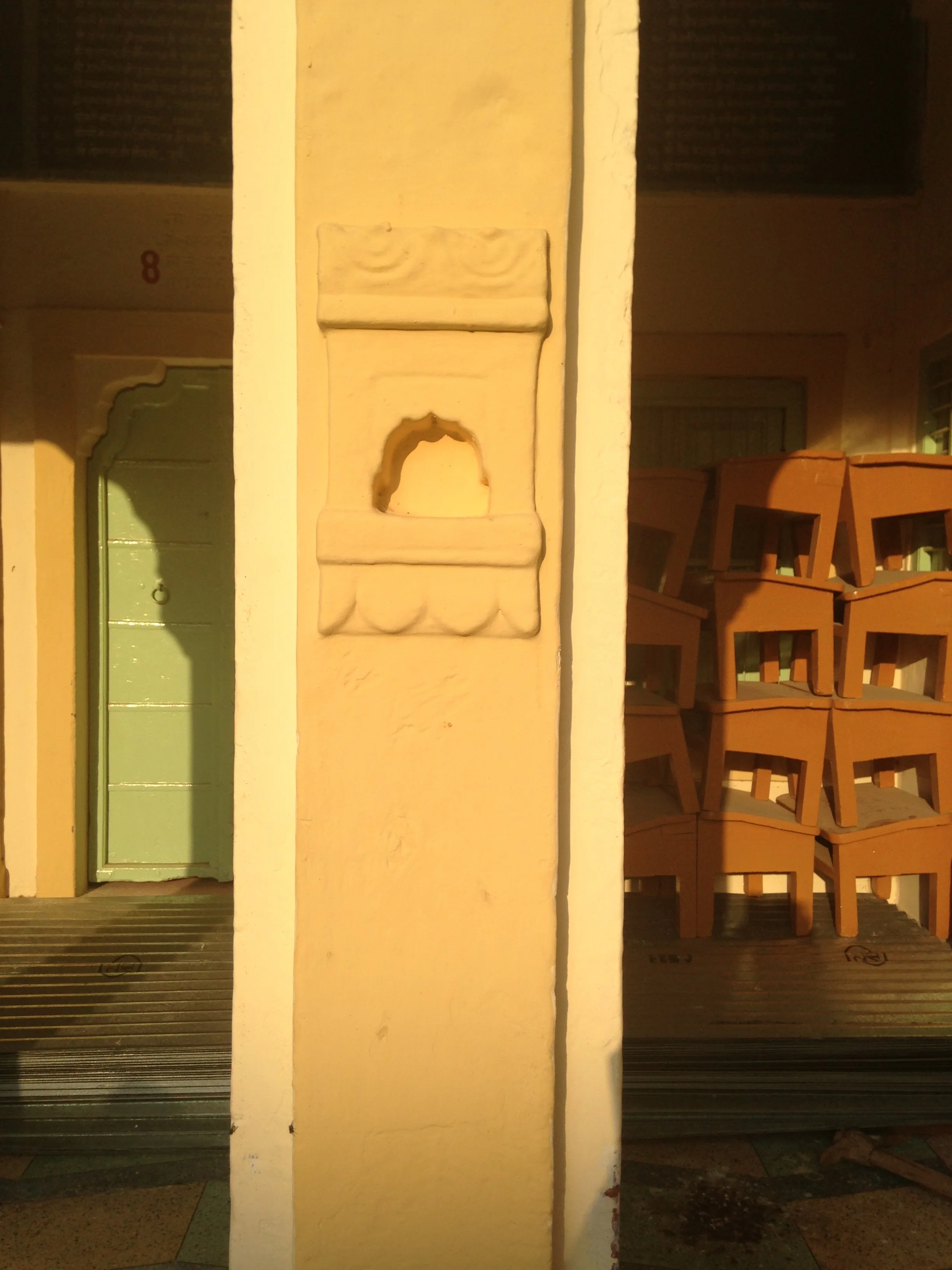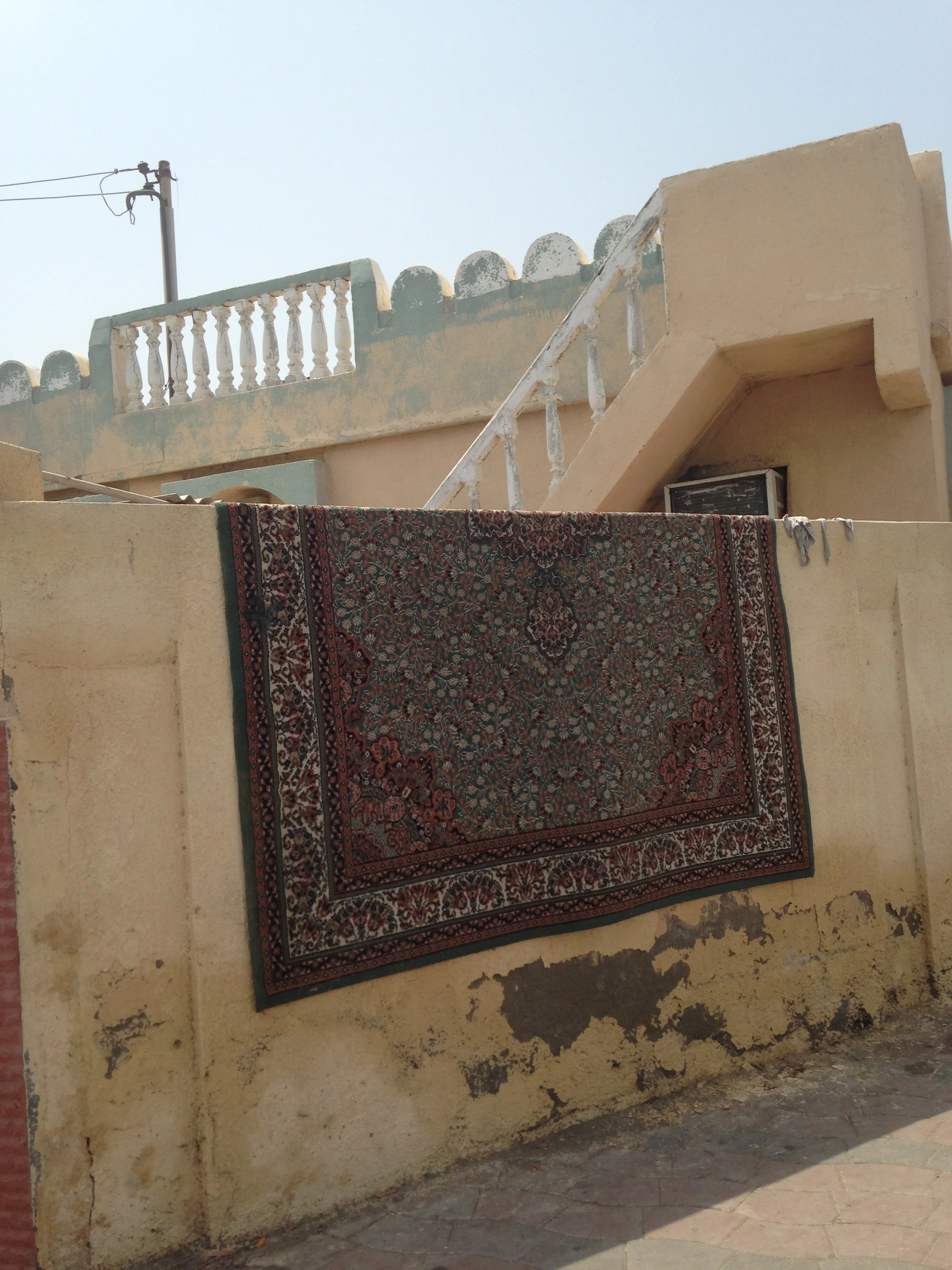The Hermit Crab’s Home
by Priyanka Sacheti
This work appears in Khabar Keslan Issue 2. PASSAGE
Original art by Knar Hovakimyan.
A perpetual mover builds her home out of words.
For the past few days, as fat gray monsoon clouds congregate over Bangalore, where I now live, I have been experiencing a peculiar lassitude, a sense of lacuna, which I usually interpret as a symptom of missing Oman. In this state, the oddly luminous rainy light engulfing my apartment recalls the brilliant sunlight that would flood my room every morning before turning into stuff of poetry at dusk, transforming mountains and desert into palettes of blush, mauve, and lavender.
Oman's scorching summer heat becomes a visceral, palpable memory and I don't miss it as much as I miss being home. Once I start remembering, I find myself being caught up in an avalanche of memories, the giant conjoined memory mass that was my time in Oman now crumbling into pieces. I sift through each distinct piece, jumping from childhood to early adulthood to adolescence, each conjuring up a set of sub-memories. I smell the mountains, petrol fumes, baking tarmac, hot desert sand—and most of all, the overwhelming scent of the sea.
Mutrah, Oman, by Priyanka Sacheti.
For most of my life, I lived in a city by the sea. However, since I moved away from Oman five years ago, I’ve lived in landlocked cities: Pittsburgh had a river, Delhi a dying one, and Bangalore is dotted with ghost lakes. I have come to observe that homesickness advances and recedes like waves, which deposit beautiful gifts at your feet. Wherever I go, I search for Oman, as if I’m cajoling it to emerge from wherever it is hidden. And sometimes, just sometimes, I chance upon it in the brilliance of papery fuchsia bougainvillea blooming against the blue sky, intricately patterned carpets draped over ochre walls, and crowded bazaars that teleport me to the souks where I grew up. It doesn't last more than a moment, this illusion of returning, but it’s enough to nourish me for a while, inducing this feeling of security—that home is just around the corner.
Bougainvillea in Oman, by Priyanka Sacheti.
The hermit crab borrows a home and lugs it on its back and I too carry around my adopted home in suitcases, layering them with an exhaustive library of memories. I am a perpetual nomad, never fully inhabiting the present, forever yearning to be somewhere else. I may be an Indian citizen but the fact that my formative years took place in Oman means that the country has shaped me like no other place in which I have lived. I am what I am because of Oman and Oman alone.
Mosque in Oman, by Priyanka Sacheti.
There is also this truth: when I was growing up in Oman a couple of decades ago, it was India I was constantly searching for. During our annual trip to India, around June-July, we would fly down to Jodhpur. Even now, I associate these months with anticipation, departure, flights, and brief but joyful displacement. We would return to Oman in August in time for school to start – and I recall the intense homesickness that would envelop me for a week. I would gloom about in the hot, dry air, yearning for India's humidity, the noise, the sheer lushness that permeated and indeed defined it. To abate this homesickness, I would either lose myself in the material objects I had carried back—books, magazines, clothes, food, audio tapes—or visit the two Hindu temples in the neighborhoods of Ruwi and Muttrah in downtown Muscat, where large numbers of Indian expats resided and which always felt more like India to me.
Jodhpur, Rajasthan, by Priyanka Sacheti.
As we drove back from the Shiva temple in Muttrah, more than two centuries old, we would stop by a little shop near the Muttrah Corniche to munch on freshly fried samosas. Muttrah represents the confluence of cultures that shaped Muscat: the Portuguese forts rising from the rocky outcrops and the still preserved traditional coastal architecture, which is a marriage of Indian and Omani architectural styles. Gujarati merchants had been trading and living in Oman since the 16th century; I would see glimpses of that past in the Gujarati script above a door in a three-storied house squeezed between other traditional buildings on the Muttrah Corniche, testifying that Oman's cultural geology is as fascinating as its physical one.
In March this year, I happened to attend the third edition of India's first Biennale, the Kochi-Muziris Biennale in the port town of Kochi, Kerala. The Biennale seeks to pay homage to both the present Kochi city's rich cosmopolitan legacy as well as its near-mythical predecessor, Muziris. A port city, Muziris played a central role in the trade between southern India and the Phoenicians, Persians, Egyptians, Greeks, and Roman Empire, primarily exporting spices and facilitating the Spice Route. It had trade dealings with Oman, too. Oman's equally rich maritime past witnessed its voyages to many lands, resulting in cultural cross-pollination—food, costume, and architecture. When I visited one of the beaches, I imagined the waters churning all the way to Oman, sailors journeying from Muscat to Kochi and back.
In 2010, friend and colleague and I worked on a research paper to present at an Indo-Oman conference. We spoke to several Indian creatives living in Muscat, wondering whether and how their temporary home had played a role in their aesthetics and creative sensibilities. Did the fact that Oman's almost-home-like air mean that India was too close to allow Oman to influence their creative production at all? Us Indian expats would ultimately never settle down in Oman: we would forever be expatriates, not immigrants who eventually assimilate into the cultures of the countries they moved to. Both the awareness of this disorienting temporariness, and the process of questioning others, found me more deeply contemplating the writing I had produced over the years - and my relationship with Oman. While I had extensively written about Oman in my journalism, I realized that very little of my fiction had much to do with Oman; for some reason, I found it impossible to do so.
Rajasthan Architecture 2, by Priyanka Sacheti
And then, I bid adieu to Oman in 2012 and the yearning to return has never left me since. This yearning is also the realization of how influential Oman has been in making me. Just as the continents were once a gigantic conjoined physical mass called Pangea and which had now split into the world that we know today, I too was a product of constantly shifting tectonic plates of cultures, Oman and India.
In an interview some years ago, Indian-American writer Jhumpa Lahiri, acclaimed for her short stories delving into the Bengali immigrant experience in the United States, remarked that her desk was her home. After moving away from Oman and having lived in Pittsburgh, Delhi and now, Bangalore, I ultimately find myself conjuring up home through words; if homesickness is a sea depositing beautiful memories at my feet, I turn them into imaginary palaces built along the coast, constructing them one word at a time.
If commerce continues to be a language binding Oman and India together, words are my personal equivalent of this cultural exchange. When I write about the searing warmth of the sun, I am thinking of May in both Muscat and Rajasthan. When I think of the sea, I see Kochi's cobalt waters juxtaposed with those of Seeb. The mountains of Oman merge with the ones that surround Bangalore. Where India ends, where Oman begins, is impossible to tell. I jigsaw my dual selves, those distinct continents of memory and identity, through my words.
Rajasthan Architecture, by Priyanka Sacheti
Streets of Muscat, by Priyanka Sacheti
Priyanka Sacheti is a cultural writer currently transiting from United States to India. Educated at Universities of Warwick and Oxford, United Kingdom, Priyanka previously lived in Muscat, Sultanate of Oman. She has published articles in various publications such as Gulf News, Brownbook, and Khaleejesque, with a special focus on art and gender. She's the author of three poetry volumes, and two of her short stories have been published in international anthologies celebrating Indian immigrant writing.








